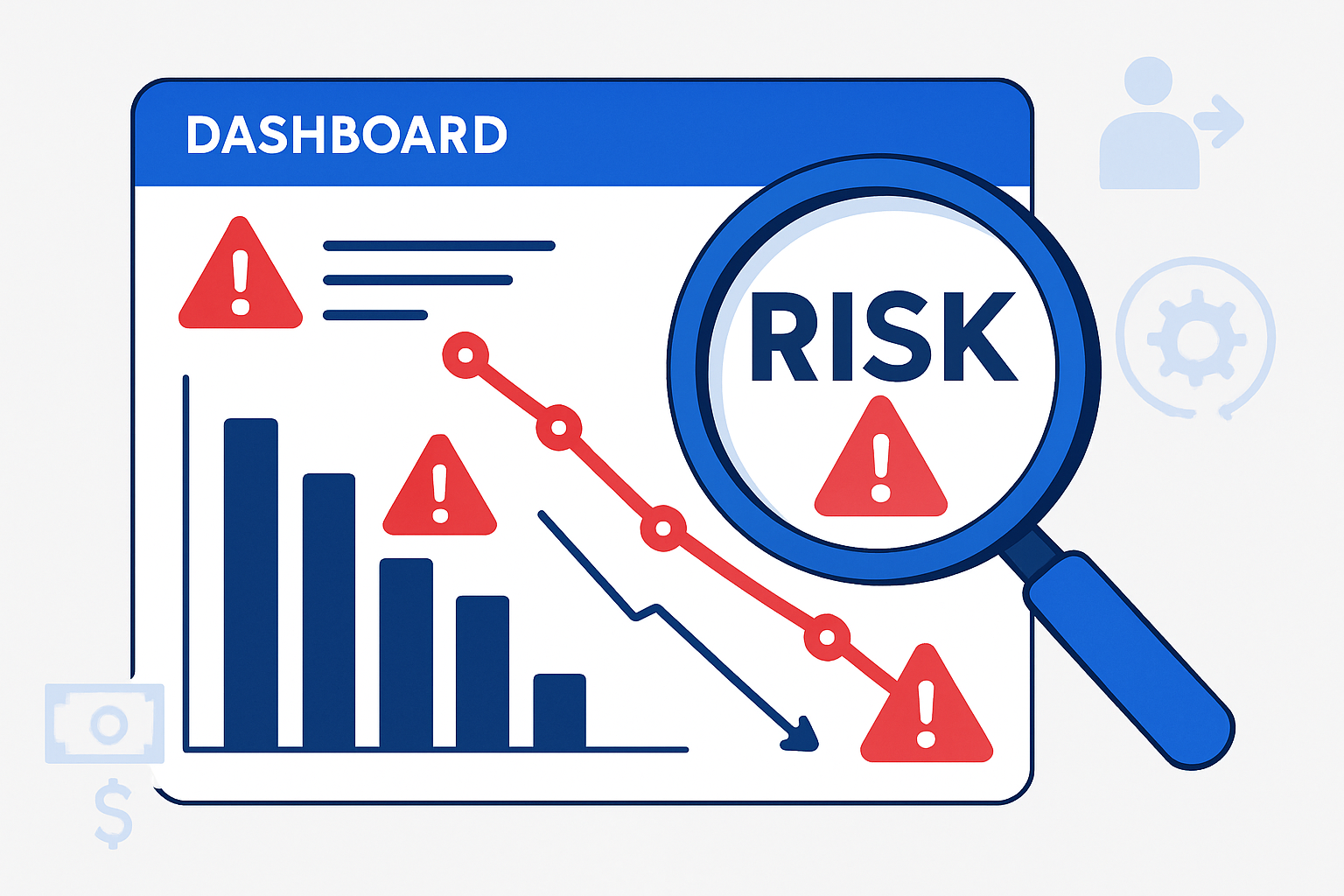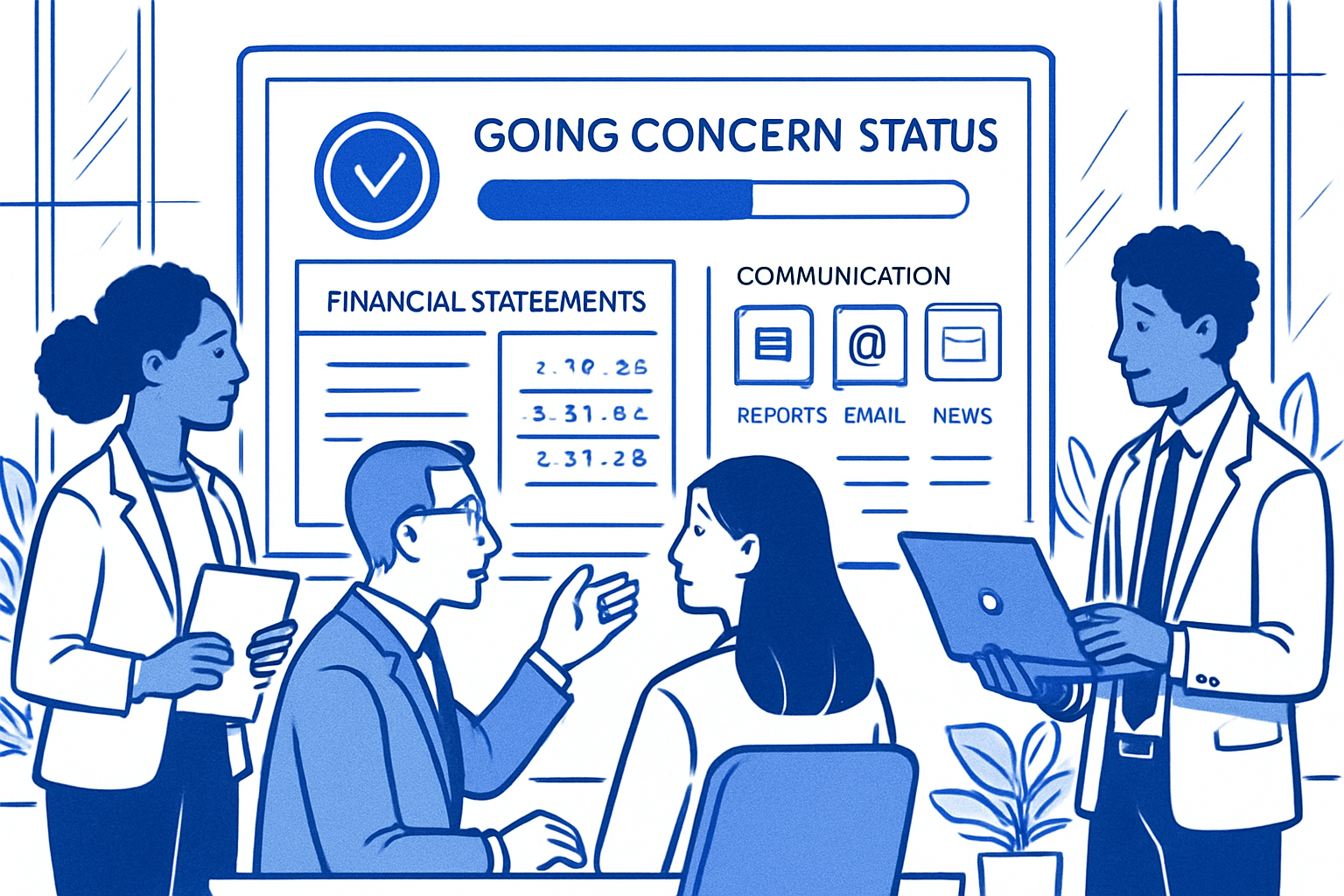Going Concern Guide: Understanding Business Continuity 2025
Imagine your business faces a sudden disruption—are you confident it would stay afloat, or would it sink? In today’s unpredictable environment, understanding the going concern principle is more important than ever.
This guide breaks down what going concern really means for your company’s survival, from accounting basics to legal and investor implications. Whether you’re a business leader, finance professional, or entrepreneur, you’ll gain practical insights to assess, maintain, and communicate your organization’s ability to keep operating.
We’ll unpack core concepts, warning signs, planning strategies, and the latest trends shaping business continuity in 2025 and beyond. Ready to future-proof your business? Read on for expert guidance and actionable steps.
Understanding the Going Concern Principle
Imagine looking at a company’s financial statements and wondering: Will this business still be here next year? That’s where the going concern principle becomes crucial. It’s a foundational concept in both accounting and business, shaping how organizations assess their long-term survival and how stakeholders interpret their financial health.
At its core, the going concern principle means a business is expected to continue operating for the foreseeable future. In other words, the company isn’t planning to liquidate or significantly scale down. This assumption underpins financial reporting, letting accountants value assets and liabilities without worrying about immediate closure or fire-sale prices.
Why is this important? The going concern assumption gives meaning to every balance sheet, income statement, and cash flow report. Without it, financial statements would have to reflect a business in wind-down mode, often painting a much bleaker picture for investors and creditors.
The concept has evolved over time. In the early days of accounting, there weren’t clear rules about how to handle failing businesses. Over decades, regulators and standard-setters refined the going concern idea to protect investors and ensure consistency across the financial world. Today, the principle is embedded in major standards like IFRS and US GAAP, requiring management to assess their company’s ability to keep operating for at least 12 months from the reporting date.
It’s easy to confuse going concern with terms like liquidation or insolvency, but they mean very different things. Here’s a quick comparison:
| Term | Definition | Implication for Business |
|---|---|---|
| Going Concern | Business expected to operate into the future | Normal operations continue |
| Liquidation | Winding up assets to pay off debts | Business ceases operations |
| Insolvency | Inability to meet financial obligations as they come due | May lead to liquidation |
The going concern principle has a direct impact on business valuation and investor confidence. If a company is considered a going concern, its assets are valued based on their continued use, not on what they’d fetch in a quick sale. This distinction affects everything from stock prices to borrowing costs. In fact, a company’s going concern status can influence its credit rating—lenders and investors watch for any signs of trouble.
Common misconceptions persist around the going concern concept. Let’s clear up a few:
- It doesn’t mean a business is guaranteed to survive, only that there’s no evidence it won’t.
- Short-term losses don’t automatically threaten going concern status.
- Auditors don’t declare a company a going concern—they assess management’s evaluation.
Understanding key financial terms is vital for interpreting going concern assessments. If you need a refresher, check the Financial terms glossary for definitions of concepts like liquidity, solvency, and more.
A real-world example brings this to life: When a company receives a “going concern” warning from its auditors, it often leads to a downgrade in its credit rating. This can drive up borrowing costs and spook investors, sometimes triggering a downward spiral.
According to the Corporate Finance Institute, going concern issues are among the most common areas of focus during audits. This underscores how critical it is for businesses to monitor their financial health and communicate transparently with stakeholders.
Ultimately, grasping the going concern principle helps business leaders, investors, and finance professionals make informed decisions—and safeguard continuity in a world where uncertainty is the only constant.

Identifying Going Concern Risks and Red Flags
Spotting going concern risks early is essential for business survival. Overlooking warning signs can leave a company vulnerable to sudden collapse, damaging stakeholder trust and putting future operations in jeopardy.

Financial Red Flags
The first step in evaluating going concern is to examine financial health. Persistent losses, negative operating cash flow, and mounting debt are classic red flags. Ratios like the quick ratio and debt-to-equity ratio help reveal liquidity issues and excessive leverage. If a company struggles to meet short-term obligations or relies heavily on external financing, its going concern status is at risk.
Common financial indicators include:
- Negative working capital
- Missed loan repayments
- Declining sales and profitability
- Inability to pay suppliers on time
Even one of these signs can signal deeper going concern concerns if not addressed promptly.
Operational and Market Risks
Beyond the balance sheet, operational issues often foreshadow going concern trouble. Losing a major customer, experiencing frequent supply chain breakdowns, or facing IT system failures can destabilize daily operations. Market shifts, such as new regulations or an economic downturn, also pose a threat.
Other operational and external warning signs:
- Key employee departures
- Ongoing legal disputes
- Rising costs without matching revenue growth
When these risks combine, the likelihood of a going concern problem increases significantly.
Auditor’s Role and Corporate Failures
Auditors act as an early warning system for going concern issues. They analyze both numbers and operations, looking for uncertainty about the company’s ability to continue for at least 12 months. According to PCAOB's AS 2415 on Going Concern, auditors must evaluate all available evidence and communicate doubts clearly to stakeholders.
High-profile failures—like Carillion in the UK—show what happens when going concern warnings are ignored. In many cases, auditors had raised concerns in advance, but management failed to act, resulting in business collapse.
Data, Importance, and Distinguishing Threats
Studies reveal that companies receiving an adverse going concern opinion are much more likely to face bankruptcy within 12 to 24 months. For investors, lenders, and employees, this highlights the importance of identifying risks early.
But not every setback signals a fundamental threat. Consider this simple comparison:
| Short-Term Setback | Fundamental Threat |
|---|---|
| One-off sales dip | Multi-year declining revenue |
| Temporary supply delay | Chronic supply chain failures |
| Seasonal cash flow crunch | Persistent negative cash flow |
Timely risk identification empowers leaders to intervene and protect the business. By distinguishing between temporary issues and lasting problems, companies can take action before a going concern crisis develops.
Steps to Assess and Maintain Business Continuity
Ensuring your organization’s going concern status is more than an annual checkbox; it’s a dynamic, ongoing process. In 2025, business leaders must systematically assess and maintain business continuity to safeguard operations and reputation. Let’s break down the essential steps every organization must take to confidently address going concern challenges.

Step 1: Conduct a Comprehensive Financial Health Check
Start by evaluating your company’s financial foundation. Focus on liquidity ratios, such as the quick ratio explained, to determine if short-term assets can cover immediate liabilities. Review debt-to-equity levels and analyze cash flow statements.
- Assess liquidity and solvency
- Examine recurring losses or negative cash flow
- Identify any breaches of loan covenants
This thorough review helps you pinpoint going concern risks early, enabling more informed decisions.
Step 2: Review Operational Resilience
Next, look at your operational backbone. Evaluate supply chain reliability, IT infrastructure, and workforce stability. Are you dependent on a single supplier? Is your technology robust enough to withstand outages?
- Map out supply chain vulnerabilities
- Assess IT system backup and recovery plans
- Gauge employee engagement and retention
Strong operational resilience minimizes disruptions that could threaten your going concern status.
Step 3: Stress-Test Business Models Against Disruptions
Prepare for the unexpected by stress-testing your business model. Simulate scenarios like pandemics, cyberattacks, or geopolitical unrest to see how your company would respond.
- Run “what if” crisis simulations
- Analyze the impact of external shocks
- Build contingency plans for worst-case scenarios
Stress-testing reveals hidden weaknesses and reinforces your going concern approach.
Step 4: Document and Disclose Going Concern Assessments
Transparency is vital. Document your findings and communicate them to internal and external stakeholders. Make sure disclosures in financial statements clearly outline any going concern uncertainties.
- Prepare detailed internal reports
- Update board and management regularly
- Ensure external disclosures meet regulatory requirements
Clear communication builds trust and fulfills both legal and ethical obligations.
Step 5: Implement Corrective Actions
If you identify going concern red flags, act swiftly. Develop and execute corrective measures to address vulnerabilities.
- Reduce unnecessary costs or restructure operations
- Secure new financing or renegotiate debt terms
- Diversify revenue streams or renegotiate with key suppliers
A proactive response can restore confidence and stabilize your business continuity.
Step 6: Monitor and Update Continuity Plans Regularly
Continuity plans are living documents. Monitor key indicators and update strategies as conditions change. According to recent industry surveys, over 60% of businesses revised their continuity plans after 2020’s disruptions.
- Schedule regular reviews of continuity protocols
- Update risk assessments with new data
- Train teams to respond to evolving threats
Continuous improvement ensures your going concern status remains strong, even as new risks emerge.
Example: Mid-Sized Manufacturer Overcoming a Supply Chain Crisis
Consider a mid-sized manufacturer who faced a sudden supply chain breakdown. By following these steps, they quickly identified the threat to their going concern status, communicated transparently with stakeholders, and implemented alternative sourcing strategies. Their proactive approach enabled them to weather the crisis and emerge stronger.
| Step | Key Actions | Outcome |
|---|---|---|
| 1. Financial Health | Analyze liquidity, debt, cash flow | Early risk detection |
| 2. Operational Resilience | Assess supply chain, IT, workforce | Minimized disruptions |
| 3. Stress-Testing | Simulate crises | Revealed vulnerabilities |
| 4. Documentation | Report and disclose | Built stakeholder trust |
| 5. Corrective Actions | Cost reduction, financing | Stabilized operations |
| 6. Monitoring | Regular updates | Ongoing resilience |
A systematic, transparent approach to going concern assessment not only satisfies regulators but also builds lasting trust with investors, employees, and customers. In today’s unpredictable landscape, staying ahead of risks is the best way to ensure your business’s continuity.
Communicating Going Concern Status to Stakeholders
In times of uncertainty, how you communicate your company’s going concern status can make or break trust with stakeholders. Transparent, timely disclosure is not just a legal requirement—it’s a strategic move that helps manage market perception and maintain investor confidence.
Crafting clear going concern disclosures in financial statements and annual reports is essential. Companies that explain risks and action plans openly are more likely to retain support. For example, studies indicate that firms with transparent risk communication are better positioned to weather crises and bounce back stronger. Let’s explore best practices for sharing going concern information with both external and internal audiences.

Navigating Media and Public Relations
Managing external messaging around going concern issues requires precision and empathy. The media can amplify concerns, so it’s vital to prepare clear, concise statements before any public disclosures. Anticipate questions from journalists and analysts by providing context and outlining your company’s action plan.
When crafting public messages, avoid jargon and be upfront about challenges. Demonstrate how leadership is addressing going concern uncertainties. For instance, referencing updated standards, such as those provided by the IFRS Foundation's Updated Going Concern Educational Material, shows your commitment to best practices and regulatory compliance.
Consider these strategies:
- Hold press briefings to proactively address concerns.
- Prepare Q&A documents for your spokesperson.
- Monitor social media for emerging narratives and respond promptly.
Companies that communicate openly about going concern risk often see less negative speculation and greater investor understanding. In contrast, vague or delayed statements can fuel uncertainty and damage reputation.
Internal Communication Best Practices
Equally important is how you communicate going concern status internally. Employees are essential stakeholders whose morale and productivity hinge on honest, timely updates. Clear internal communication reduces rumors and helps teams stay focused.
Best practices include:
- Regular updates via town halls or internal newsletters.
- Open-door policies for questions about going concern matters.
- Training sessions to help staff understand the implications.
Effective leaders foster trust by sharing both challenges and solutions. When employees grasp the company’s going concern outlook and see leadership taking action, engagement and resilience increase. This approach not only supports business continuity but also strengthens your organization’s culture during turbulent times.
Trends Shaping Business Continuity and Going Concern in 2025
The landscape for business continuity and going concern is evolving faster than ever. In 2025, companies face a wave of new challenges and opportunities that demand a fresh approach to resilience. What trends are shaping the way organizations assess and safeguard their going concern status?
Digital Transformation and Resilience
Digital transformation is at the heart of business continuity in 2025. Organizations are leveraging cloud computing, automation, and advanced analytics to streamline processes and strengthen their ability to withstand disruptions. With more data-driven decision-making, businesses can identify going concern risks earlier and respond faster.
Remote work has become a permanent fixture for many firms. This shift introduces both flexibility and new vulnerabilities, such as increased cybersecurity threats and the need for robust IT infrastructure. Companies that invest in digital resilience are better positioned to maintain going concern, even when facing sudden operational shocks.
ESG and Regulatory Pressures
Environmental, Social, and Governance (ESG) factors are now central to going concern assessments. Investors and regulators expect companies to address climate risks, labor practices, and ethical governance as part of their continuity planning. Firms integrating ESG into their core strategy are not only more attractive to stakeholders but also more resilient.
Regulatory scrutiny has intensified since the crises of 2020. Auditors and boards must now adhere to stricter standards when evaluating going concern. For example, the IAASB's ISA 570 (Revised 2024), Going Concern sets enhanced requirements for auditors to assess and disclose going concern risks, raising the bar for transparency and accountability.
AI, Data Analytics, and Operational Risks
Artificial intelligence and data analytics are transforming risk management. AI-powered tools can scan vast datasets to flag early warning signs of financial or operational stress. By automating risk detection, businesses can monitor their going concern status in real time and act before problems escalate.
However, as technology advances, so do the threats. Cybersecurity risks, data breaches, and supply chain vulnerabilities are more complex than ever. Companies must balance innovation with robust risk controls to protect their going concern.
Case Study and Future Predictions
Consider technology-driven companies leading the charge in continuity planning. These organizations use scenario modeling, real-time monitoring, and digital communication tools to adapt quickly. One global survey found that 70% of CFOs are increasing investments in business continuity technologies for 2025, signaling a widespread shift toward proactive risk management.
Looking ahead, expect the line between financial health and operational resilience to blur. Going concern evaluations will become more dynamic, integrating financial metrics, ESG data, and real-time risk analytics.
Summary Table: Key Trends Impacting Going Concern
| Trend | Impact on Going Concern |
|---|---|
| Digital Transformation | Enables earlier risk detection, faster response |
| ESG Factors | Mandate broader risk assessment |
| Regulatory Changes | Stricter disclosure and audit standards |
| AI & Data Analytics | Real-time monitoring, predictive insights |
| Remote Work | New risks, demands resilient infrastructure |
Businesses that embrace these trends will not only protect their going concern but also gain a competitive edge in a volatile world.
Resources and Further Reading
Navigating the complexities of going concern requires up-to-date knowledge and trusted resources. Whether you're a seasoned finance leader or just starting to explore business continuity, having the right references at your fingertips is essential for effective decision-making.
Below is a curated list of authoritative sources and practical tools to deepen your understanding of going concern and business continuity:
Key Standards & Guides
- International Financial Reporting Standards (IFRS) and US GAAP sections on going concern
- Financial Reporting Council (FRC) guidance and the Securities and Exchange Commission (SEC) publications
Essential Readings & Tools
- Thomson Reuters' Guidance on Going Concern for Audit Engagements offers in-depth analysis of audit considerations, updated for current economic challenges.
- Debt-to-equity ratio insights help you assess financial leverage, a key factor in going concern risk evaluations.
- Books like "Business Continuity and Risk Management: Essentials of Organizational Resilience" and "IFRS Guidebook" by Steven Bragg
- Recent whitepapers from Big Four firms on business continuity planning and risk management
Professional Support & Training
- The Association of Chartered Certified Accountants (ACCA) and the American Institute of CPAs (AICPA) provide training, webinars, and audit checklists
- Online courses on platforms such as Coursera and LinkedIn Learning
Staying informed and leveraging these resources will help you proactively manage your company's going concern status and boost your business's resilience in 2025 and beyond.
Now that you’ve explored the essentials of business continuity and the going concern principle, you know how crucial it is to understand the patterns and lessons hidden in financial history. Imagine having a tool that lets you spot these trends, learn from past market events, and make smarter decisions for the future. We’re building exactly that—a unique platform to help you connect the dots between yesterday’s news and tomorrow’s strategy. If you’re as passionate about future-proofing your business as we are, join our beta and help us bring history to life.
